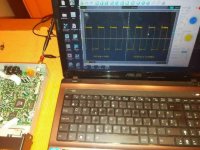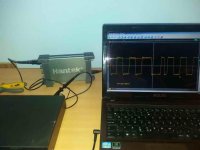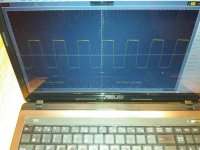Hi,
I had some thoughts on the RCA SPDIF connection:
Normally the impedance of these connections should be 75 Ohm. It seems like most RCA sockets and plugs have lesser impedance.
Now if we look at the end to end connection we have following impedances:
Source: 75 Ohm
Source cable connection: < 75 Ohm
Cable: 75 Ohm
Target cable connection: < 75 Ohm
Receiver: 75 Ohm
--> Impedance is changing 4 times, each change produces signal reflection
--> wouldnt it be better to use a cable matching the sockets and plugs with an impedance lower than 75 Ohm? Then the impedance would only change twice. (At least for short cables)
Could that be the reason why RCA audio cable work without any problems?
What do you think?
I had some thoughts on the RCA SPDIF connection:
Normally the impedance of these connections should be 75 Ohm. It seems like most RCA sockets and plugs have lesser impedance.
Now if we look at the end to end connection we have following impedances:
Source: 75 Ohm
Source cable connection: < 75 Ohm
Cable: 75 Ohm
Target cable connection: < 75 Ohm
Receiver: 75 Ohm
--> Impedance is changing 4 times, each change produces signal reflection
--> wouldnt it be better to use a cable matching the sockets and plugs with an impedance lower than 75 Ohm? Then the impedance would only change twice. (At least for short cables)
Could that be the reason why RCA audio cable work without any problems?
What do you think?
I think that the connectors are so much shorter than the waveforms of S/PDIF signals that they don't cause any issues in practice. If you are perfectionistic, you can replace the RCA connectors with 75 ohm BNC connectors. They are more reliable than RCA anyway.
Blue Jean Cables claims that the Canare RCAP-series of RCA plugs is the closest to 75 ohm of any of the RCA plugs that they have tested, so if you are sticking with RCA, that is what I would use. BNC of course would be a true 75 ohm impedance. I know Jocko used to tell people to make the cable at least 3 feet long to avoid as many reflections as possible.
I measured SPDIF signals a couple of times, various cables, various lengths, RCA and BNC. I didn't notice any reflections even with the 50ohm BNC cable that came with the oscilloscope. I think SPDIF has too low frequencies and too long wavelengths for that.
It is more a thought experiment
Is it correct that we talk about some MHz and then a wavelength of 40 meters?
If small areas of impedance mismatch are ignored by much longer wavelength then our discussion with cable length of about 1m is more or less irrelevant, correct?
Is it correct that we talk about some MHz and then a wavelength of 40 meters?
If small areas of impedance mismatch are ignored by much longer wavelength then our discussion with cable length of about 1m is more or less irrelevant, correct?
At the risk of spreading bad information, I thought the wavelength, in copper cable, of the SPDIF signal was about 1m, not 40... This was the rational for avoiding 1m long cables, and using 1.5 meters....
As far as I remember, sampling rate 192kHz corresponds to SPDIF frequency of 12.3MHz, and 44.1kHz to 2.8MHz. I only measured at 44.1kHz and there the wavelength in a typical coaxial cable is over 50m. The exact values of the wavelength or the signal propagation speed probably depend on the insulation material of the cable itself.
And I also measured with very short cables of 30 cm, there are no visible reflections.
What can be seen is that different CD and DVD players have different forms of signals at the output. Some are almost pure squares, and some have very irregular distorted signals. And it all works somehow. 🤔
And I also measured with very short cables of 30 cm, there are no visible reflections.
What can be seen is that different CD and DVD players have different forms of signals at the output. Some are almost pure squares, and some have very irregular distorted signals. And it all works somehow. 🤔
Attachments
Last edited:
There is no fixed standard but the common and lowest SPDIF signal used in many consumer audio components has a sampling rate of 44.1khz, the wavelength of that is only a few mm.
A few millimetres as a sound wave in air, not as an electromagnetic wave in a cable.
I am responding to Nixie62 but a bit surprised that nobody warned yet about it: reflections are generated by the fast edges of digital signals, not periods.. You must calculate the equivalent bandwith which characterise the rising/falling edges.
The well known formula is:
BW= 0,35/ Trise(10-90%)
That is, if you observe 3,5nsec rise time of an spdif signal, that means 100MHz equivalent bandwith.
But such a slow edge gives room to jitter generation in the receiver - better transmitters should have faster risetimes, like 1nsec.. >> 350MHz equiv. bandwith or more..
When I played with these things I observed easily reflections in actual SPDIF systems..
Obviously Not with a 10MHz bandwith scope.
That signal edge with 1nsec Trise will propagate ~1m of cable in 5nsec. The reflection propagates backwards again in 5nsec. So 10nsec after the signal edge there could appear a reflection in a 1m unterminated/ badly terminated line.
in a ~10cm cable 1nsec after the 1nsec rising edge there could appear a reflection. With 3cm in 300ps cca.. in that case it starts to distort the edge itself. 3cm is close to RCA connectors lengths..
The well known formula is:
BW= 0,35/ Trise(10-90%)
That is, if you observe 3,5nsec rise time of an spdif signal, that means 100MHz equivalent bandwith.
But such a slow edge gives room to jitter generation in the receiver - better transmitters should have faster risetimes, like 1nsec.. >> 350MHz equiv. bandwith or more..
When I played with these things I observed easily reflections in actual SPDIF systems..
Obviously Not with a 10MHz bandwith scope.
That signal edge with 1nsec Trise will propagate ~1m of cable in 5nsec. The reflection propagates backwards again in 5nsec. So 10nsec after the signal edge there could appear a reflection in a 1m unterminated/ badly terminated line.
in a ~10cm cable 1nsec after the 1nsec rising edge there could appear a reflection. With 3cm in 300ps cca.. in that case it starts to distort the edge itself. 3cm is close to RCA connectors lengths..
Ah now we get somewhere (greetings from Fourier😀)
Then the initial question is still valid: would it make sense to reduce impedance borders by not using a 75 Ohm cable?
Then the initial question is still valid: would it make sense to reduce impedance borders by not using a 75 Ohm cable?
Thanks for the clarification, now I understand what's going on. Unfortunately, I'm an amateur, obviously I don't have professional equipment to see those reflections.When I played with these things I observed easily reflections in actual SPDIF systems..
I just noticed that different SPDIF and TOSLINK cables give me different sound. I'm not sure what the impact of those reflections is, but the fact remains that the cables sound different.
I noticed the same thing about USB cables, there are higher frequencies, it's certainly an even worse situation. I haven't found two cables that sound exactly the same. Unfortunately, I cannot measure that at all.
Last edited:
That is interesting, I checked with Toslink and simple RCA cable and there was no difference when I switched within the DAC,not even a pop or gap. But also exactly the same sound
Calculate the wavelength at approximately 70% of the speed of light for an EM wave in the cable.What?
Sorry but it's not possible to alter the tone, warmth, HF extension, or any other analog aspect of a digital audio transmission with a cable, it either works perfectly and gives you EXACTLY what is in the recording or it's broken/faulty, and if it's faulty it will result in audible dropouts(glitches) with no sound at all.I just noticed that different SPDIF and TOSLINK cables give me different sound. I'm not sure what the impact of those reflections is, but the fact remains that the cables sound different.
I noticed the same thing about USB cables, there are higher frequencies, it's certainly an even worse situation. I haven't found two cables that sound exactly the same. Unfortunately, I cannot measure that at all.
This is because none of the analog characteristics we associate with audio even exist until they are recreated when the digital signal is converted back into an analog form in whatever device is performing that task, and because the digital signal itself bears no resemblence at all to an analog signal and contains a whole bunch more "stuff" mixed in with the digital representation of the audio tracks that all has to be separated and procesed to complete the task.
A good way to "see" how digital signal transmission works is with digital video, when streaming something online and you lose connection(even momentarily) do you get wierd colors or smearing of images on your TV/monitor/tablet? No.. you usually get a perfectly crisp clean frozen image which represents the last complete packet of data recieved before the signal dropped.
When I first decided to switch to a digital sound source (CD) in 1995, I was of the same opinion, that is, I hoped it would be like that. It was even one of the main reasons I left turntables and vinyl records. It means a digital sound source, a perfect procession of zeros and ones, there is no mistake, no noise, rumble and various distortions. However, it turned out to be a little more complicated than that. I keep a few USB, TOSLINK and SPDIF cables for those who don't believe that there can be a sound difference. I don't want to convince anyone of anything or to discuss a lot what is possible and what is not. Anyone can buy or borrow a cheap generic cable and compare it with a better, more expensive, branded one and hear for themselves whether there is a difference.Sorry but it's not possible
Last edited:
- Home
- Source & Line
- Digital Line Level
- Impedance of RCA S/PDIF connection



